二叉树常见oj题(持续更新中)
【摘要】 @toc 一:根据二叉树创建字符串题目介绍:(题目链接)代码:class Solution {public: string tree2str(TreeNode* root) { string ss; treecopy(root,ss); return ss; } void treecopy(TreeNode* root,str...
@toc
一:根据二叉树创建字符串
- 题目介绍:(题目链接)

- 代码:
class Solution {
public:
string tree2str(TreeNode* root) {
string ss;
treecopy(root,ss);
return ss;
}
void treecopy(TreeNode* root,string& str) //传引用减少构造
{
if(root == nullptr)
return ;
str+= to_string(root->val);
if(root->left || root -> right)
{
str+="(";
treecopy(root->left,str);
str+=")";
}
if(root->right)
{
str+="(";
treecopy(root->right,str);
str+=")";
}
}
};
- 思路:
利用的是前序遍历
- 注意:
- 左子树和右子树的判断条件 : 1. if(root->left || root -> right) (假如左子树或者右子树不为空,则执行左) 2. if(root->right) (只有当右子树不为空时,执行右分支)
- to_string的利用
- void treecopy(TreeNode* root,string& str) (传引用减少构造)
二:二叉树层序遍历
题目描述:(题目链接)
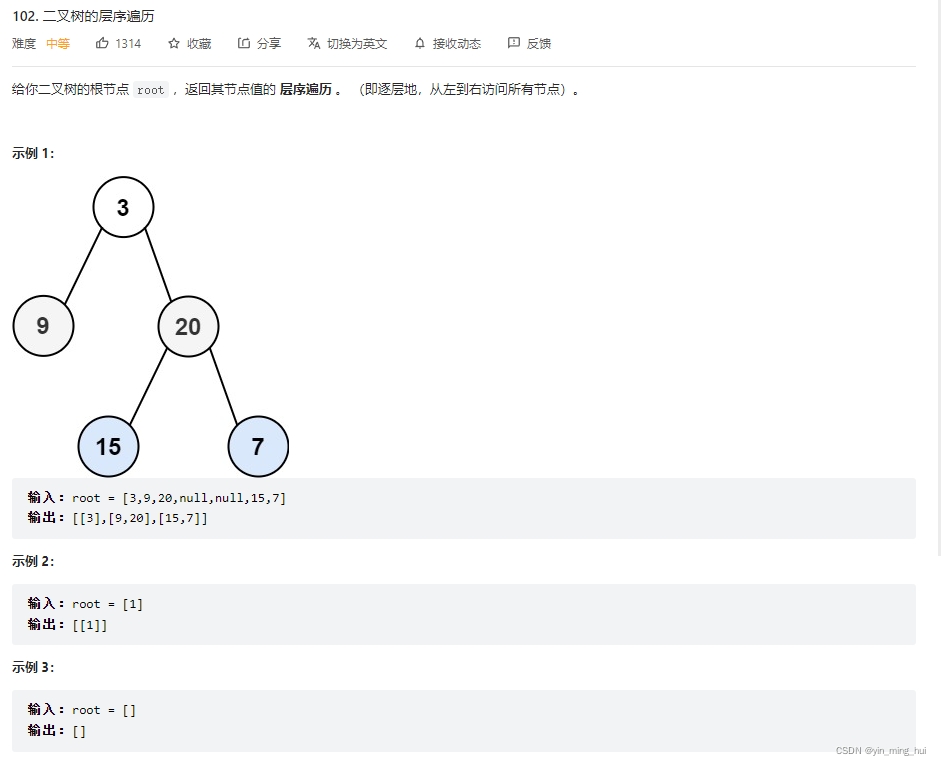
- 方法一:
class Solution {
public:
vector<vector<int>> levelOrder(TreeNode* root) {
vector<vector<int>> vv;
if(root ==nullptr)
return vv;
queue<TreeNode*> q;
q.push(root);
int numsize =1;
while(!q.empty())
{
//一层一层的遍历
vector<int> v;
for(int i=0;i<numsize;i++)
{
TreeNode* cur = q.front();
q.pop();
v.push_back(cur->val);
if(cur->left)
q.push(cur->left);
if(cur->right)
q.push(cur->right);
}
vv.push_back(v);
numsize = q.size();
}
return vv;
- 思路:
- 记录当前层数的个数, 一层一层的遍历
- 利用了队列先进先出的特性
- 注意事项:
- 注意队列函数的使用 : q.front() 取出队头的数据
q,back() 取队尾的数据
(需要注意是的栈只能取队尾的数据,不能取对头的) - 注意for循环的使用和numsize的更新,for(int i=0;i<numsize;i++), numsize = q.size();
- 方法二:
class Solution {
public:
vector<vector<int>> levelOrder(TreeNode* root) {
vector<vector<int>> vv;
if(root ==nullptr)
return vv;
queue<TreeNode*> q;
q.push(root);
int numsize =1;
while(!q.empty())
{
TreeNode* cur = q.front(); //取出队列的头
v.push_back(cur->val);
q.pop();
numsize--;
if(cur->left)
q.push(cur->left);
if(cur->right)
q.push(cur->right);
if(numsize==0)
{
vector<int> tem =v;
v.clear();
vv.push_back(tem);
numsize = q.size();
}
}
return vv;
}
};
三:二叉树的层序遍历 II
- 题目描述: (题目链接)

- 代码:
class Solution {
public:
vector<vector<int>> levelOrderBottom(TreeNode* root) {
vector<vector<int>> vv;
if(root ==nullptr)
return vv;
queue<TreeNode*> q;
q.push(root);
int numsize =1;
while(!q.empty())
{
//一层一层的遍历
vector<int> v;
for(int i=0;i<numsize;i++)
{
TreeNode* cur = q.front();
q.pop();
v.push_back(cur->val);
if(cur->left)
q.push(cur->left);
if(cur->right)
q.push(cur->right);
}
numsize =q.size();
vv.push_back(v);
}
reverse(vv.begin(),vv.end());
return vv;
}
};
- 思路:
reverse一下就得到了
四:二叉树的最近公共祖先
- 题目描述: 题目链接

- 方法一:
class Solution {
public:
bool find(TreeNode* root, TreeNode* p)
{
if(root==nullptr)
return false;
if(root==p)
return true;
return find(root->right,p) || find(root->left,p);
}
TreeNode* lowestCommonAncestor(TreeNode* root, TreeNode* p, TreeNode* q) {
//特殊情况
if(root== p || root == q)
return root;
bool IsRightp=find(root->right,p);
bool IsRightq=find(root->right,q);
bool IsLeftp=!IsRightp;
bool IsLeftq=!IsRightq;
if(IsLeftp && IsLeftq)//全在左边
{
return lowestCommonAncestor(root->left,p,q);
}
else if(IsRightp && IsRightq)//全在右边,就玩右边找
{
return lowestCommonAncestor(root->right,p,q);
}
else{
return root;
}
}
};
- 思路:
- 逻辑:找到第一个祖先, 有一个节点在祖先的左,有一个节点在祖先的右
- .时间复杂度:N*N 算最坏的情况(第一次findN,第二次find N-1…),因为find的时间复杂度是O(N)
- 注意:
bool IsLeftp=!IsRightp;
bool IsLeftq=!IsRightq;
取反可以就不用再去递归左树了
- 方法二:
bool findpath(TreeNode* root,stack<TreeNode*>& st,TreeNode* p)
{
if(root==nullptr)
return false;
st.push(root); //先将root 入进栈
if(root==p) //找到了
{
return true;
}
//往左边找
if(findpath(root->left,st,p))
{
return true; //左边找到了
}
//往右边找
if(findpath(root->right,st,p))
{
return true; //右边找到了
}
//左右子树都没找到
st.pop();
return false;
}
TreeNode* lowestCommonAncestor(TreeNode* root, TreeNode* p, TreeNode* q) {
stack<TreeNode*> stp,stq;
findpath(root,stp,p);
findpath(root,stq,q);
int psize = stp.size();
int qsize = stq.size();
int max = psize >qsize? psize : qsize;
int min = psize+qsize-max;
stack<TreeNode*>* maxst = max== psize? &stp : &stq;
stack<TreeNode*>* minst = max== psize? &stq : &stp; //找到长度大的和长度小的
int size = max - min;
while(size--)
{
maxst->pop();
}
while(maxst->top()!=minst->top())
{
maxst->pop();
minst->pop();
}
return maxst->top();
}
};
- 思路:
- 找到p,q的路径
- 他们两个路径的交点就是共同祖先
- 两个栈交点的问题 可以理解为 链表交点问题来解决
- 时间复杂度为O(N)
- 注意:
- 主要是findpath函数的实现,主要流程为:
- 先将root入进栈,再判断root是否为P,为p则找到了,return true
- 再判断左子树和右子树, if(findpath(root->left,st,p)) 假如左树找到了,则return true
- 假如左右子树都没找到,则pop出栈顶的元素
五:二叉树的前中后序遍历(非递归版)
前序
- 方法一:
通用法,前后中序都基于此思路
class Solution {
public:
vector<int> preorderTraversal(TreeNode* root) {
//先将左树全部入栈,再出,入右
stack<TreeNode*> st;
vector<int> v;
//流程法
TreeNode* cur =root; //要访问的树
while(cur || !st.empty())
{
while(cur) //一直往左入
{
v.push_back(cur->val);
st.push(cur);
cur = cur->left;
}
//左边入完了
TreeNode* tem= st.top();
st.pop();
cur = tem->right; //左数完了,再去入右树
}
return v;
}
};
- 思路:
- 先将左子树入栈,边入边push_back
- 左边入完了,再将本节点pop,入右树
- 注意:
- 注意判断条件: while(cur || !st.empty()) ,当本节点不为空或者栈不为空的时候,进循环
- TreeNode* tem= st.top(); //先将栈顶节点pop掉,因为已经push_back了
st.pop();
cur = tem->right; //左数完了,再去入右树
- 方法二:
简洁法
class Solution {
public:
vector<int> preorderTraversal(TreeNode* root) {
//先将左树全部入栈,再出,入右
stack<TreeNode*> st;
vector<int> v;
//简洁法
if(root==nullptr)
return v;
st.push(root);
while(!st.empty())
{
TreeNode* cur = st.top();
st.pop();
v.push_back(cur->val);
if(cur->right)
st.push(cur->right);
if(cur->left)
st.push(cur->left);
}
return v;
}
};
中序
class Solution {
public:
vector<int> inorderTraversal(TreeNode* root) {
stack<TreeNode*> st;
vector<int> v;
TreeNode* cur =root; //要访问的树
while(cur || !st.empty())
{
while(cur) //一直往左入
{
st.push(cur);
cur = cur->left;
}
//左边入完了
TreeNode* tem= st.top();
st.pop();
v.push_back(tem->val); //左子树完了。访问根
cur = tem->right;
}
return v;
}
};
与前序不同的是 v.push_back(tem->val);的时机
后序
- 方法一:
将前序的结果反转即可得到后序的结果
- 方法二:
class Solution {
public:
vector<int> postorderTraversal(TreeNode* root) {
vector<int> v;
if(root == nullptr)
return v;
stack<TreeNode* > st;
TreeNode* cur = root;
TreeNode* prev = nullptr;
while(cur || !st.empty())
{
//先去左边循环
while(cur)
{
st.push(cur);
cur = cur->left;
}
TreeNode* top = st.top(); //取栈顶的数据
if(top->right == nullptr || top->right == prev)
{
v.push_back(top->val);
st.pop();
prev =top;
}
else
{
cur = top->right;
}
}
return v;
}
};
- 思路:
- 先入左数
- 再取栈顶元素
- 判断,假如(栈顶的右子树为空,或者 右子树为之前访问过的节点),就push_back,再pop,更新prev= 栈顶的元素
- 如果假如不成立,则再取栈顶的左树去找
- 注意:
- 注意 if(top->right == nullptr || top->right == prev) 判断条件
六:二叉搜索树与双向链表
- 题目描述:题目链接

- 代码:
class Solution {
public:
void Inoder(TreeNode* cur,TreeNode*& prev)
{
if(cur==nullptr)
return;
Inoder(cur->left,prev);
cur->left = prev;
if(prev)
prev->right = cur;
prev =cur;
Inoder(cur->right,prev);
}
TreeNode* Convert(TreeNode* pRootOfTree) {
if(pRootOfTree == nullptr)
return pRootOfTree;
TreeNode* prev = nullptr;
Inoder(pRootOfTree,prev);
TreeNode* head = pRootOfTree;
while(head->left)
head = head->left;
return head;
}
};
- 思路:
- 利用中序遍历链接整颗树
- 用一个prev指针指向前一个被访问的节点,然后当前节点的左子树指向 prev,假如prev不为空,prev的右子树指向当前节点,再更新pre。
- 最后递归右子树
- 注意:
- 注意prev要传引用,因为prev是要实时变化的
- 链表的头不要格外的去记录,因为是双向链表,一直 往左就找到了
七:从前序与中序遍历序列构造二叉树
- 题目描述:题目链接

- 代码:
class Solution {
public:
TreeNode* _buildTree(vector<int>& preorder,int& start,
vector<int>& inorder,int left,int right)
{
if(left>right)
return nullptr;
//先由根构建节点
TreeNode* root = new TreeNode(preorder[start]);
start++;
//再利用中序去寻找左右子树的边界
int preleft = left;
int i = root->val;
while(left<=right)
{
if(i == inorder[left])
{
break;
}
else
left++;
}
root->left = _buildTree(preorder,start,inorder,preleft,left-1);
root->right = _buildTree(preorder,start,inorder,left+1,right);
return root;
}
TreeNode* buildTree(vector<int>& preorder, vector<int>& inorder) {
int start =0;
return _buildTree(preorder,start,inorder,0,inorder.size()-1);
}
};
- 思路:
利用前序找到根节点,再通过中序找到左右子树,从而构造出了一整颗树
- 注意:
- 递归结束的条件:left>right
- 注意start要传引用,因为要实时变化的。
八:后继者
- 题目:题目链接

- 代码:
class Solution {
public:
TreeNode* inorderSuccessor(TreeNode* root, TreeNode* p) {
if(root==nullptr)
return root;
TreeNode* cur = inorderSuccessor(root->left,p);
if(cur != nullptr)
return cur;
if(root->val > p->val) //找到第一个大于P的值
return root;
return inorderSuccessor(root->right,p);
}
};
- 思路:
中序找到第一个比p大的值就是后续
九:左子树之和
- 题目:(题目链接)

方法一:
- 代码:
class Solution {
public:
void _sumOfLeftLeaves(TreeNode* root,int& sum){
if(root == nullptr)
return ;
if(root->left!=nullptr && root->left->right==nullptr && root->left->left ==nullptr)
sum += root->left->val;
_sumOfLeftLeaves(root->left,sum);
_sumOfLeftLeaves(root->right,sum);
}
int sumOfLeftLeaves(TreeNode* root) {
int sum=0;
_sumOfLeftLeaves(root,sum);
return sum;
}
};
方法二:
- 代码:
class Solution {
public:
int sumOfLeftLeaves(TreeNode* root) {
int sum=0;
_sumOfLeftLeaves(root,sum);
return sum;
if(root==nullptr)
return 0;
int leftsum = sumOfLeftLeaves(root->left);
int rightsum = sumOfLeftLeaves(root->right);
int tem =0;
if(root->left!=nullptr && root->left->right==nullptr && root->left->left ==nullptr)
tem = root->left->val;
return leftsum+rightsum+tem;
}
};
- 思路:
递归去找左树上和右树上的左叶子节点,相加即可
- 注意:
特别要注意的是 左叶子节点的判断条件:root->left!=nullptr && root->left->right==nullptr && root->left->left ==nullptr
十:找树左下角的值
- 题目:(题目链接)

方法一:
层序遍历,找到最下面一层,最先从队列里出来的树
方法二:
- 代码:
class Solution {
public:
int high=0,ret=0;//high 来记录当前最左节点的高度,ret记录答案
void _findBottomLeftValue(TreeNode* root,int deep)
{
if(root==nullptr)
return;
if(root->left==nullptr && root->right ==nullptr) //因为是前序遍历,所以同一高度,左树优先
{
if(deep > high)
{
ret=root->val;
high =deep;
}
}
if(root->left) _findBottomLeftValue(root->left,deep+1);
if(root->right) _findBottomLeftValue(root->right,deep+1);
}
int findBottomLeftValue(TreeNode* root) {
ret =root->val;
_findBottomLeftValue(root,high);
return ret;
}
};
- 思路:
- 记录当前最左节点的高度,如果找到叶子节点的高度大于之前的,则该叶子节点为当前树的左下角
- 因为是前序遍历,所以同一层的,左子树优先,所以可以求出左下角
- 注意:
注意全局变量的使用
十一:路径总和
- 题目: (题目链接)

- 代码:
/**
* Definition for a binary tree node.
* struct TreeNode {
* int val;
* TreeNode *left;
* TreeNode *right;
* TreeNode() : val(0), left(nullptr), right(nullptr) {}
* TreeNode(int x) : val(x), left(nullptr), right(nullptr) {}
* TreeNode(int x, TreeNode *left, TreeNode *right) : val(x), left(left), right(right) {}
* };
*/
class Solution {
public:
bool hasPathSum(TreeNode* root, int targetSum) {
return _hasPathSum(root,0,targetSum);
}
bool _hasPathSum(TreeNode* root, int curSum,int targetSum)
{
if(root==nullptr)
{
return false;
}
curSum+= root->val;
if(root->left==nullptr && root->right==nullptr)
{
if(curSum == targetSum)
return true;
else
return false;
}
if(_hasPathSum(root->left,curSum,targetSum))
return true;
if(_hasPathSum(root->right,curSum,targetSum))
return true;
return false;
}
};
十二: 从前序与中序遍历序列构造二叉树
- 题目:(题目链接)

*代码:
/**
* Definition for a binary tree node.
* struct TreeNode {
* int val;
* TreeNode *left;
* TreeNode *right;
* TreeNode() : val(0), left(nullptr), right(nullptr) {}
* TreeNode(int x) : val(x), left(nullptr), right(nullptr) {}
* TreeNode(int x, TreeNode *left, TreeNode *right) : val(x), left(left), right(right) {}
* };
*/
class Solution {
public:
TreeNode* _buildTree(vector<int>& preorder,int& start,
vector<int>& inorder,int left,int right)
{
if(left>right)
return nullptr;
//先由根构建节点
TreeNode* root = new TreeNode(preorder[start]);
start++;
//再利用中序去寻找左右子树的边界
int preleft = left;
int i = root->val;
while(left<=right)
{
if(i == inorder[left])
{
break;
}
else
left++;
}
root->left = _buildTree(preorder,start,inorder,preleft,left-1);
root->right = _buildTree(preorder,start,inorder,left+1,right);
return root;
}
TreeNode* buildTree(vector<int>& preorder, vector<int>& inorder) {
int start =0;
return _buildTree(preorder,start,inorder,0,inorder.size()-1);
}
};
总结:
二叉树的oj题考察的主要是递归思想的运用和 非递归时,对整个递归流程的理解。
只有理解好递归的整个过程和思路,才能更好地学好二叉树
- 多写,多思考,多复习,多总结!!
- 持续更新中!!!
【声明】本内容来自华为云开发者社区博主,不代表华为云及华为云开发者社区的观点和立场。转载时必须标注文章的来源(华为云社区)、文章链接、文章作者等基本信息,否则作者和本社区有权追究责任。如果您发现本社区中有涉嫌抄袭的内容,欢迎发送邮件进行举报,并提供相关证据,一经查实,本社区将立刻删除涉嫌侵权内容,举报邮箱:
cloudbbs@huaweicloud.com
- 点赞
- 收藏
- 关注作者


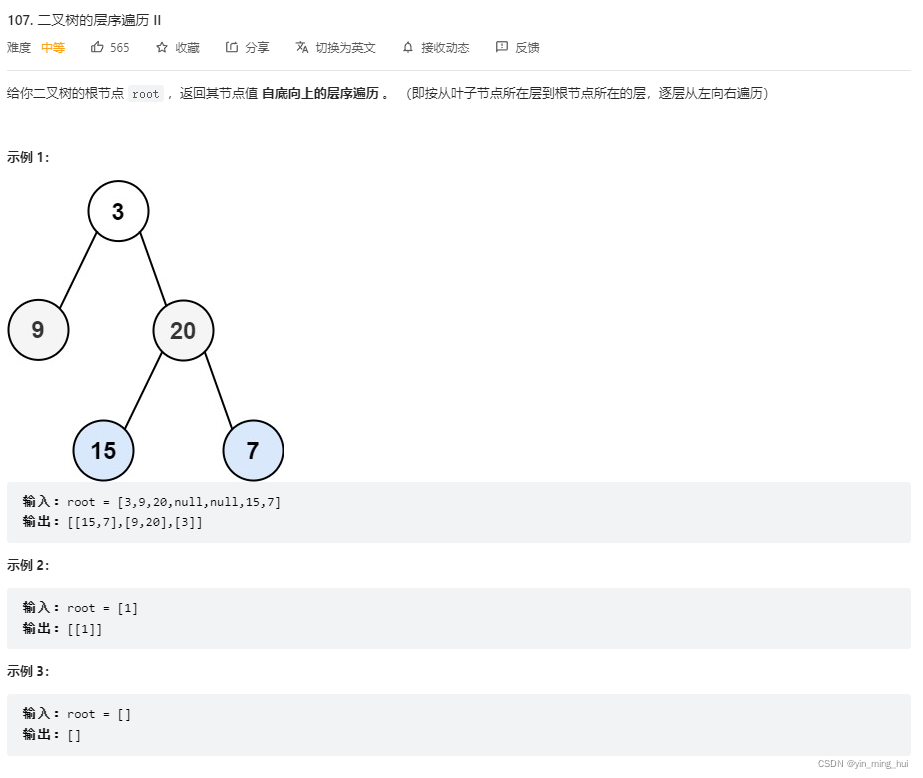
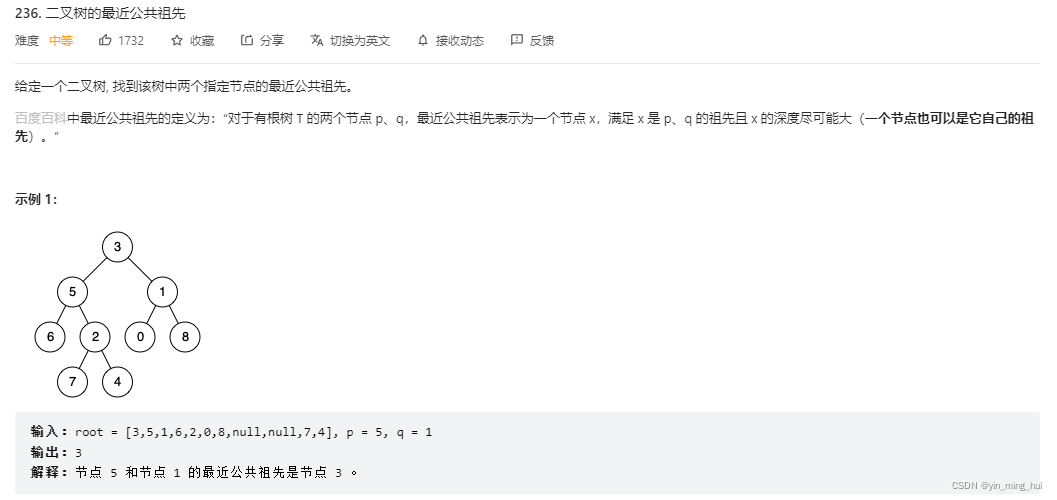
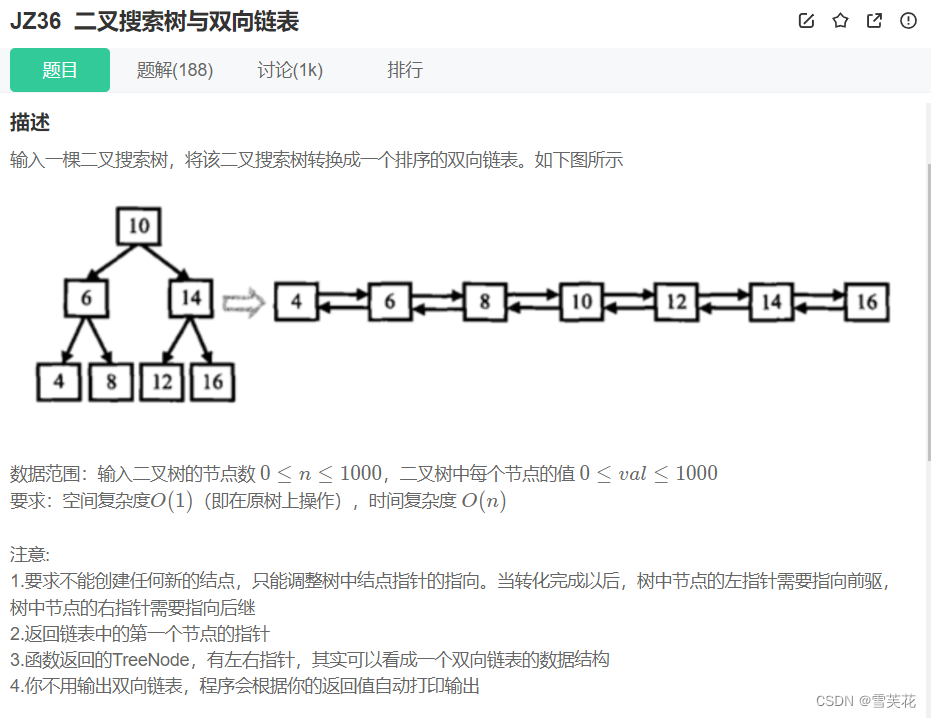
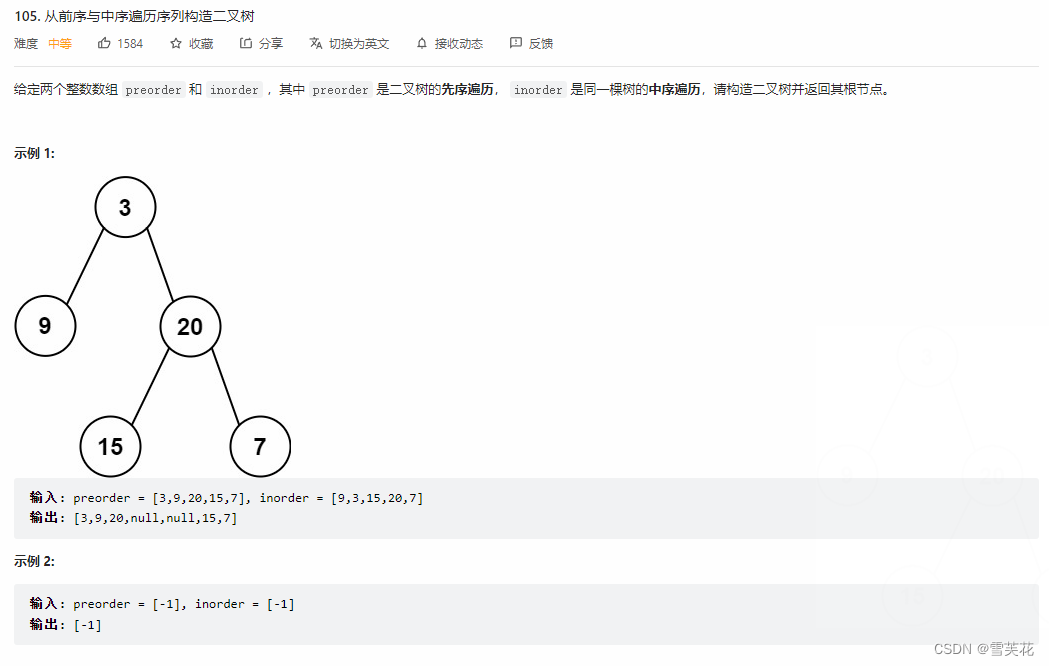
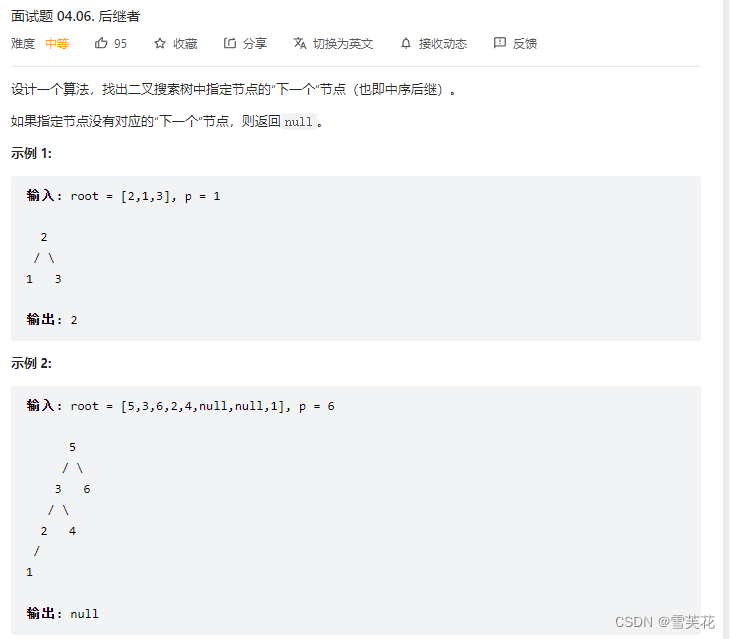


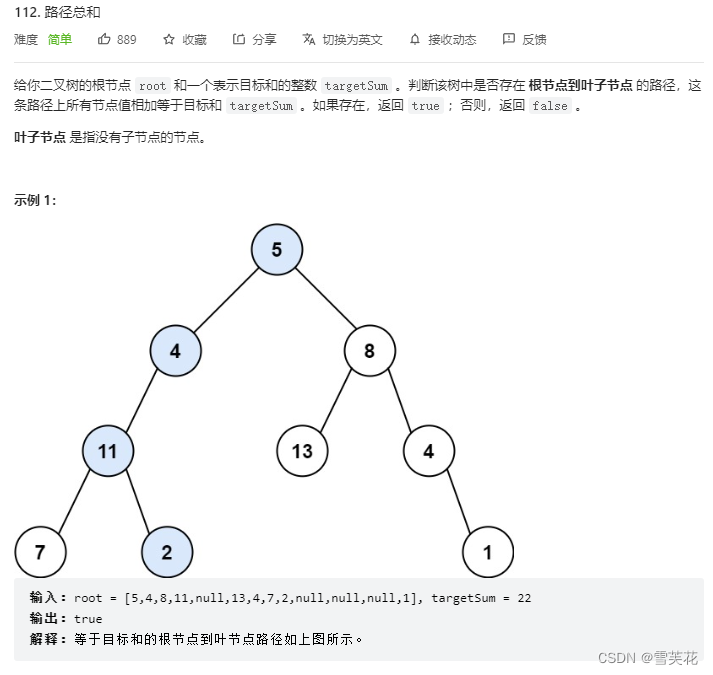


评论(0)